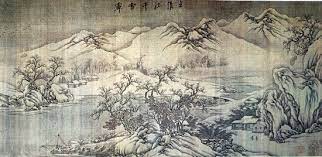왕유(王維) Wang Wei
중국 성당(盛唐)의 시인·화가로서 자는 마힐(摩詰)이다.


왕유는 시인이자 동시에 화가로써 수묵화가 뛰어났다. 화가들은 그의 그림을 두고 그의 필치는 「천기(天機)」 즉 하늘로부터 내려온 것이지 사람이 배워서 도달할 수 있는 경지가 아니라고 평하였다고 한다. 그는 먹으로만 흰 고양이 그림을 그리고 채색은 공인들에게 맡겼다. 왕유의 화풍은 오도현(呉道玄)을 닮아 있었지만 풍격은 보다 걸출하였고, 정건(鄭虔), 필굉(畢宏)과 함께 3절로 불렸다. 같은 시대의 화공 이사훈(李思訓)에 버금간다는 평가도 있다. 명대에는 산수화 분야에서 이사훈을 북종화의 선조, 왕유를 남종화(문인화)의 선조로 쳤다.
만당(晩唐) 시기의 장언원(張彦遠)은 《역대명화기》(歴代名画記)에서 왕유의 그림을 두고 필력에 강력한 힘이 느껴진다고 평가하면서도 동시에 너무 기교에 치중해 있다고 비판하기도 했다. 한편으로 같은 만당 시기의 주경현(朱景玄)은 《당조명화록》(唐朝名画録)에서 제4위 「묘품상」(妙品上)으로 평가하며 그의 작품들을 절찬하였다. 후대 북송의 소식(蘇軾)도 왕유의 시와 그림을 평해 「시 속에도 그림이 들어 있고, 그림 속에도 시가 들어 있다」라는 평을 남겼다.
또, 말의 화가로서 알려진 한간(韓幹)을 발굴한 인물이기도 한데, 젊은 한간의 그림에서 그의 재능을 알아보고 자금 지원을 해 주어 그림에 전력할 수 있게 해 주었고 한간이 대성할 수 있었다는 일화도 있다.
그의 시는 친교가 있던 맹호연을 닮은 데가 많으나 맹호연의 시보다 날카롭다. 또한 불교신자로서 관념적인 '공(空)'의 세계에의 동경을 노래한 것이 있다. 한때 관직을 물러났을 때 망천(輞川=지금의 허난성)에 별장을 짓고, 그 별장의 경물을 소재로 하여 노래한 〈죽리관(竹里館)〉이나 〈녹시(鹿柴)〉(모두 5언절구)는 특히 유명하다. 왕유는 또한 화가로서도 뛰어나서, 남송화(南宋畵)의 시조(始祖)로서 추앙된다. "왕유의 시를 보면, 시 중에 그림이 있다"고 송(宋)의 소식은 평하고 있다.
Chinese poet, musician, painter, and politician during the Tang dynasty. He was one of the most famous men of arts and letters of his time. Many of his poems are preserved, and twenty-nine were included in the highly influential 18th-century anthology Three Hundred Tang Poems.
Works
Wang Wei was famous for both his poetry and his paintings, about which Su Shi coined a phrase: "The quality of Wang Wei’s poems can be summed as, the poems hold a painting within them. In observing his paintings you can see that, within the painting there is poetry."[28] He is especially known for his compositions in the Mountains and Streams (Shanshui) poetry genre, the landscape school of poetry, along with Meng Haoran; their family names were combined in a form of mutual reference and they are commonly referred to as "Wang Meng" due to their excellence in poetic composition, as contemporaries. In his later years, Wang Wei lost interest in being a statesman and became more involved in Buddhism and his poems reflected his focus on Chan practice, therefore he was posthumously referred to as the "Poet Buddha". His works are collected in Secretary General Wang's Anthology, which includes 400 poems. He excelled in painting images of people, bamboo forests and scenery of mountains and rivers. It is recorded that his landscape paintings have two different genres, one of the Father and Son of the Li Family (李氏父子) and the other being of strong brush strokes. His work of Picture of Wang River is of the latter, but unfortunately the original no longer exists. His works of Scenery of Snow and Creek and Jinan’s Fusheng Portrait are both realistic in their representation of the subjects.
Poetry
At present 420 poems are attributed to Wang Wei, of which 370 are thought to be genuine.[29] Wang Wei was a "very great master" of the jueju:[30] many of his quatrains depict quiet scenes of water and mist, with few details and little human presence. The Indiana Companion comments that he affirms the world's beauty, while questioning its ultimate reality. It also draws a comparison between the deceptive simplicity of his works and the Chan path to enlightenment, which is built on careful preparation but is achieved without conscious effort.
One of Wang Wei's famous poems is "One-hearted" (Xiang Si 相思):
| Original Chinese | English Translation |
|---|---|
| 相思 紅豆生南國 春來發幾枝 願君多採擷 此物最相思 | One-Hearted When those red berries of the South, Flush on the branches in the spring, Take home an armful, for my sake, As a symbol of our love. |
Wang River Collection
Main article: Wangchuan ji
Some of Wang Wei's most famous poetry was done as a series of couplets written by him to which his friend Pei Di wrote replying couplets. Together, these form a group titled the Wang River Collection. Note that "Wang" as in the river is a different character that the "Wang" of Wang Wei's name. It literally refers to the outside part of a wheel; and also that these are sometimes referred to as the "Lantian poems", after the real name of Wang's estate's location, in what is now Lantian County. Inspired in part by Wang's Lantian home and features of its neighborhood and by their correspondences with other places and features, the collection includes such pieces as the poem often translated "Deer Park" (literally, "Deer Fence").[31] However, the poems tend to have a deceptive simplicity to them, while they actually have great depth and complexity upon closer examination.
Painting
Main article: Chinese painting
Wang Wei has historically been regarded as the founder of the Southern School of Chinese landscape art,[32] a school which was characterised by strong brushstrokes contrasted with light ink washes.
